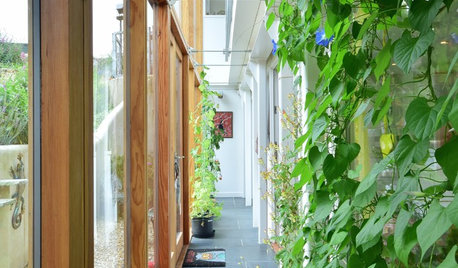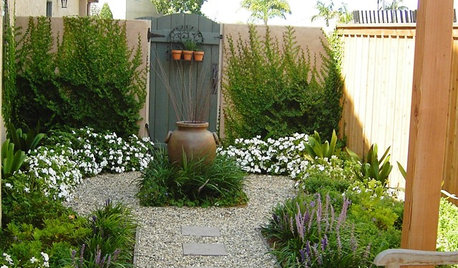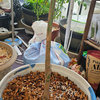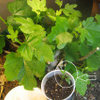Fungus gnats just not going away!
Heruga (7a Northern NJ)
7 years ago
Featured Answer
Comments (52)
Heruga (7a Northern NJ)
7 years agorhizo_1 (North AL) zone 7
7 years agoRelated Discussions
fungus gnats living in the soil...ruining my plant?long with pics
Comments (9)The above statement is just wrong, fungus gnats do cause harm. If there is root damage they will eat the rotting flesh much like any maggot. I don't know how many times I've had to completely remove a plant and wash it in a bleach solution to kill the little buggers because they have gotten into a small cut in the stem of a plant or root tips. First off do not use any organic stuff like peat, second use lots of chunky stuff like pumice or perlite, and pot it in a clay pot which is just large enough to take the root ball, no bigger. Do not let it sit in water ever. Invest in wooden bbq skewers. Use one to go into the soil about three inches, if it comes back wet or with soil on it, give it a couple of days before watering again. You can also tell by the color of the clay pot, if it's darker, it doesn't need water, if it lightens up and the soil is dry, water. Top dressing will be the death of your plant especially if you don't know the ups and downs of watering yet. It should only be used if you plan on showing your plant, or you really know what you're doing water wise. I'll tell you why, top dressing is used to keep the soil from caking, but also to retain moisture in the soil. Unless you live in a really dry hot area, I would not advise it for a Dief....See MoreFungus gnats in compost bin
Comments (14)A compost pile, heap, is where we emulate Ma Nature and change out vegetative waste into something that has major benefits to the soils under our feet. If one is going to build a compost pile it should be something more then a heap of stuff tossed together willy nilly that really is nothing more than a garbage pile. That is the reason for paying attention to the materials put in. A person could very well bury the same material in the soil and get the same results, something called trench composting, and in a year or two that could be feeding any plants growing there while putting the same material into a properly built compost pile could be ready to do the same thing in less then 6 months. Things such as Fungus Gnats are a symptom of a problem that should be addressed. Should things such as Fungus Gnats be in a compost pile? No! Because they indicate things are not functioning properly in that compost pile....See MoreFungus Gnats (organic type control)
Comments (5)Jose I use Fungicide 3 from Garden Safe. It contains Neem Oil and I can vouch for how good it works. I recommend using the other organic means along with the Garden Safe product. Vinnie Here is a link that might be useful: Fungicide 3...See MoreHow to get rid of fungus gnats without pesticides
Comments (5)My grandfather used to control gnats in the house in a similar fashion. Put a banana peel in your stainless sink and let the gnats gather there. Bring in a small propane torch and make a quick pass over the peels. You might be able to use a bananal peel to lure the gnats away from your plant before you hit them with the heat gun. Somehow, I'm in love with the heat gun trick. It just seems very manly!...See MoreHeruga (7a Northern NJ)
7 years agoPacNorWreck
7 years agoJontte Kinnu
7 years agohobbyartisan (Saskatoon, SK Canada, 2b)
7 years agotropicofcancer (6b SW-PA)
7 years agolast modified: 7 years agoJean
7 years agocalamondindave
7 years agoHeruga (7a Northern NJ)
7 years agoJontte Kinnu
7 years agonctropics
7 years agohobbyartisan (Saskatoon, SK Canada, 2b)
7 years agoraee_gw zone 5b-6a Ohio
7 years agoByron Lee
7 years agoHeruga (7a Northern NJ)
7 years agoHeruga (7a Northern NJ)
7 years agotropicofcancer (6b SW-PA)
7 years agoHeruga (7a Northern NJ)
7 years agotropicofcancer (6b SW-PA)
7 years agolast modified: 7 years agoRick80027
7 years agoHeruga (7a Northern NJ)
7 years agotropicofcancer (6b SW-PA)
7 years agoHeruga (7a Northern NJ)
7 years agoJontte Kinnu
7 years agoHeruga (7a Northern NJ)
7 years agotropicofcancer (6b SW-PA)
7 years agoHeruga (7a Northern NJ)
7 years agotropicofcancer (6b SW-PA)
7 years agoHeruga (7a Northern NJ)
7 years agotropicofcancer (6b SW-PA)
7 years agoHeruga (7a Northern NJ)
7 years agolast modified: 7 years agoLaura LaRosa (7b)
7 years agotropicofcancer (6b SW-PA)
7 years agoHeruga (7a Northern NJ)
7 years agotropicofcancer (6b SW-PA)
7 years agoHeruga (7a Northern NJ)
7 years agoLaura LaRosa (7b)
7 years agoHeruga (7a Northern NJ)
7 years agoSammers510
7 years agocalamondindave
7 years agolast modified: 7 years agoHeruga (7a Northern NJ)
7 years agotropicofcancer (6b SW-PA)
7 years agoHeruga (7a Northern NJ)
7 years agolast modified: 7 years agotropicofcancer (6b SW-PA)
7 years agoHeruga (7a Northern NJ)
7 years agotropicofcancer (6b SW-PA)
7 years agoHeruga (7a Northern NJ)
7 years agotropicofcancer (6b SW-PA)
7 years ago
Related Stories

GARDENING GUIDESHealthy Home: How to Go Green With a Living Wall or Roof
See 10 ways to add this earth-friendly element to your home
Full Story
GARDENING GUIDESHow to Turn a Side Yard Into a Glorious Garden Room
With just 8 feet or so, you can turn a plain side yard into a garden that lets you get carried away
Full Story
GARDENING GUIDESNew Ways to Think About All That Mulch in the Garden
Before you go making a mountain out of a mulch hill, learn the facts about what your plants and soil really want
Full Story
CONTAINER GARDENS7 Deer-Resistant Flowers for Your Summer Containers
Grow these as protection for edibles or just for their colorful beauty — deer might not like them, but everyone else will
Full Story
MOST POPULAR20 Outstanding Outdoor Living Rooms
Why give up style and comfort just because you add fresh air? Turn any porch or patio into a sumptuous room by following these leads
Full Story
GARDENING GUIDESEssential Watering Tips for Your Edible Garden
To give your edible plants just what they need, check out these guidelines for how, when and how much to water
Full Story
HEALTHY HOMEWhat You Need to Know About Dust and How to Fight It
Breathe easier with these 10 tips for busting mites, dander and other microscopic undesirables
Full Story
GARDENING AND LANDSCAPINGTake a Summer Vacation in the Backyard
From Airstreams to tepees, backyard camping provides all the comforts of home with a touch of rustic
Full Story
EDIBLE GARDENSGarden BFFs? Why Your Vegetables Are Begging for Companion Plants
Foster friendships among plants for protection from pests, pollination support and color camaraderie
Full Story
PLANTING IDEASGreat Garden Combo: Rose + Clematis for Small-Space Impact
We all need somebody to lean on. And when a rose supports a climbing vine, the results can totally transform a small garden
Full Story






tropicofcancer (6b SW-PA)